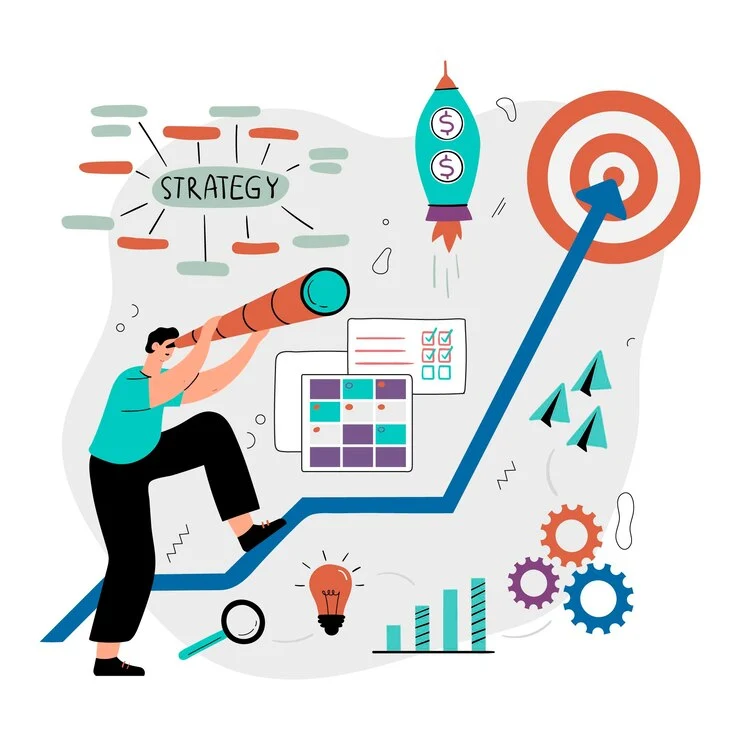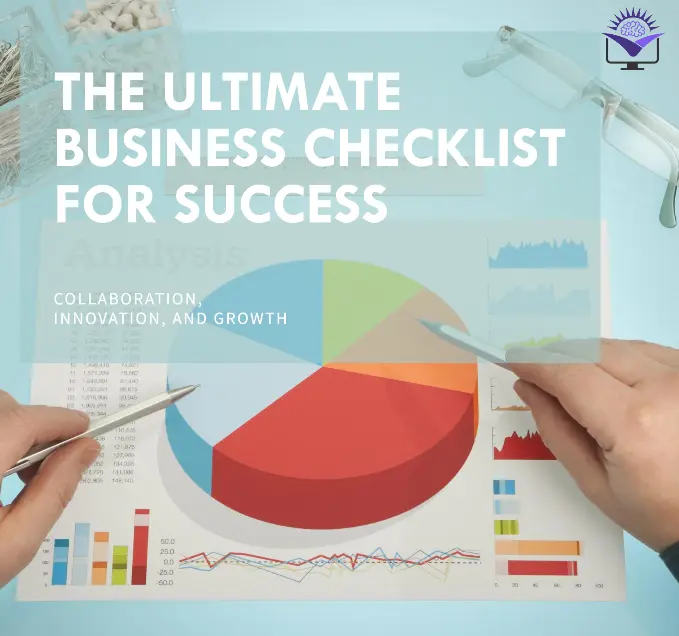In today’s fast-paced business world, effective management and strategic development are the twin pillars that support long-lasting success. Whether you’re an entrepreneur launching a new venture, a small business owner looking to grow, or a seasoned manager optimizing operations, grasping and applying key principles of business management and development is crucial. This checklist provides a detailed guide to navigating the complexities of running and expanding a successful business. We’ll cover strategic planning, financial management, marketing, and operational efficiency to equip you with the tools and insights needed to thrive in a competitive environment.
Let’s dive in!
Understanding Business Management and Development
What is Business Management?
Business management involves coordinating and organizing business activities. It includes overseeing operations, allocating resources, and implementing strategies to achieve company goals. Effective management requires leadership, communication, and analytical thinking. Key components are planning, organizing, leading, and controlling, each playing a critical role in ensuring smooth operations and goal achievement.
What is Business Development?
Business development focuses on creating long-term value from customers, markets, and relationships. This means identifying and pursuing new growth opportunities, whether by expanding into new markets, forming strategic partnerships, or developing new products and services. Key components include market research, strategic planning, and relationship management, with the ultimate goal of driving sustainable growth and ensuring the company’s long-term success.
The Synergy Between Management and Development
Combining business management and development is vital for success. Effective management ensures efficient operations and optimal resource use, creating a stable foundation for growth. Strategic development drives innovation and expansion, opening new revenue streams and market presence. Together, they form a cohesive strategy that maintains current operations while exploring new opportunities and adapting to market changes.
Strategic Planning for Business Success

Setting Clear Objectives and Goals
Clear, achievable objectives are the cornerstone of successful business management and development. Use the SMART criteria: Specific, Measurable, Achievable, Relevant, and Time-bound. Align these goals with your company’s mission and vision to ensure every effort contributes to the broader purpose. For example, if you aim to be a market leader, your objectives might include expanding your customer base by 20% within a year or launching a new product line by the end of the quarter. Clear objectives provide direction and motivation, focusing efforts on what truly matters.
Conducting Market Research and Analysis
Thorough market research and analysis are essential for understanding the market landscape and making informed decisions. Study industry trends, analyze competitor strategies, and identify the needs and preferences of your target audience. Market research provides valuable insights that can inform product development, marketing strategies, and business expansion plans. Use surveys, focus groups, and data analysis tools to gather and interpret market data, providing a solid foundation for strategic planning.
Developing a Business Plan
A well-crafted business plan serves as a roadmap for success, outlining the strategies and actions needed to achieve your objectives. Essential elements include an executive summary, company description, market analysis, organizational structure, product or service offerings, marketing and sales strategies, and financial projections. A comprehensive business plan guides operations and attracts investors by demonstrating the business’s feasibility and potential. Regularly review and update your plan to ensure it remains relevant and aligned with your goals.
Building a Strong Organizational Structure

Defining Roles and Responsibilities
Clearly defining roles and responsibilities is crucial for efficient operations. Each team member should understand their duties and how they contribute to overall success. This clarity helps avoid confusion, reduce conflicts, and ensure tasks are completed effectively. Create a well-defined hierarchy promoting accountability and transparency, enhancing productivity, and fostering a positive work environment. Use organizational charts and job descriptions to ensure everyone understands their place within the company.
Effective Communication Channels
Effective communication is essential for smooth operations and collaboration. Clear, open communication ensures information flows seamlessly between levels and departments, enabling quick decision-making and problem-solving. Implement internal communication systems like regular meetings, email updates, and collaborative platforms to keep everyone informed and engaged. Encourage a culture of open communication where employees feel comfortable sharing ideas and concerns, leading to increased innovation and a stronger sense of community.
Creating a Positive Company Culture
A positive company culture drives employee satisfaction and productivity. Foster an environment where employees feel valued, supported, and motivated to perform their best. Promote collaboration, respect, and continuous improvement, leading to higher engagement and loyalty. Provide opportunities for professional development, recognize achievements, and ensure a healthy work-life balance. Prioritizing employee well-being and creating a supportive work environment attracts and retains top talent, driving long-term success.
Financial Management and Sustainability

Budgeting and Financial Planning
Effective budgeting and financial planning are foundational for successful business management and development. A detailed budget helps allocate resources efficiently, ensuring funds are directed to critical areas. A comprehensive budget covers operational costs, marketing expenses, employee salaries, and contingency funds. Financial planning goes beyond budgeting, encompassing long-term strategies and forecasting future financial needs. Anticipating potential financial challenges and opportunities allows informed decision-making that supports growth and sustainability. Regularly review and adjust your budget based on actual performance to stay on track.
Managing Cash Flow
Cash flow management is crucial for financial health. Positive cash flow ensures a company can meet obligations, invest in new opportunities, and weather downturns. Monitor incoming and outgoing cash, optimize payment terms with suppliers, and maintain reserves for unexpected expenses. Accelerate receivables by offering early payment discounts and improving invoicing processes. Stay on top of cash flow to avoid liquidity problems and ensure resources for ongoing operations and growth.
Investment and Funding Options
Exploring investment and funding options supports expansion and innovation. Consider equity financing, debt financing, grants, and crowdfunding. Each option has pros and cons; choose based on your business’s needs and circumstances. Attracting investors requires a compelling business plan, a clear value proposition, and a track record of success. Be prepared to negotiate terms and provide regular updates to investors. Securing adequate funding allows investment in new projects, expanding operations, and driving long-term growth.
Marketing and Sales Strategies
Developing a Marketing Plan
A robust marketing plan is vital for reaching potential customers and driving sales. Outline key objectives, target audience, competitive positioning, and tactics. Use a mix of traditional and digital channels like social media, content marketing, email marketing, and paid advertising. Understand the customer journey and create personalized campaigns to enhance engagement and conversion rates. Regularly analyze performance and adjust strategies based on data-driven insights to keep marketing efforts effective and aligned with business goals.
Building a Strong Brand
Branding differentiates your business from competitors and builds customer loyalty. A strong brand communicates your values, mission, and unique value proposition. Consistent branding across touchpoints—website, social media, packaging, customer service—creates a cohesive, memorable experience. Key elements include defining brand identity, crafting a compelling brand story, and developing distinctive visual and verbal language. Investing in branding establishes a strong market presence and fosters long-term customer relationships.
Enhancing Sales Performance
Optimizing sales performance drives revenue growth and achieves business objectives. Understand customer needs, offer tailored solutions, and build strong relationships. Train your sales team to enhance their skills and effectiveness. Implement a structured sales process supported by CRM tools to improve efficiency and consistency. Set clear targets, monitor performance, and provide feedback and incentives to motivate your team. Focusing on sales excellence increases market share and drives sustainable growth.
Operational Efficiency and Productivity
Streamlining Business Processes
Streamlining processes enhances operational efficiency and reduces costs. Identify and eliminate inefficiencies to improve productivity and profitability. Regularly review processes and look for opportunities to simplify, automate, and optimize tasks. Implement technology solutions like project management software, ERP systems, and automation tools to enhance workflow efficiency and accuracy. Continuously improving processes allows businesses to achieve higher levels of excellence and focus on strategic initiatives.
Quality Control and Continuous Improvement
Maintaining high-quality standards ensures customer satisfaction and business success. Implement quality management systems like Total Quality Management (TQM) or Six Sigma for consistent product and service quality. Continuous improvement involves assessing performance, identifying areas for enhancement, and implementing changes for better outcomes. Techniques like root cause analysis, process mapping, and benchmarking support improvement efforts. Fostering a culture of quality and continuous improvement enhances competitiveness and delivers superior customer value.
Managing Supply Chain and Inventory
Effective supply chain and inventory management ensures timely product delivery and minimizes costs. Coordinate sourcing, production, and distribution activities. Build strong supplier relationships, optimize logistics, and implement just-in-time (JIT) inventory systems. Focus on maintaining optimal stock levels to meet demand without overstocking. Use demand forecasting, inventory turnover analysis, and automated tracking to manage inventory effectively. Optimizing these processes improves efficiency and customer satisfaction.
Leadership and Team Development
Developing Leadership Skills
Effective leadership is the cornerstone of a successful business. Great leaders inspire, motivate, and guide their teams toward common goals. Key qualities include strong communication, emotional intelligence, decisiveness, and the ability to foster a positive culture. Leadership training programs, workshops, mentoring, and online courses provide valuable insights and tools. Create opportunities for leaders to gain experience through challenging projects and cross-functional roles to strengthen their capabilities.
Building High-Performance Teams
Building high-performance teams involves selecting the right mix of skills, fostering collaboration, and promoting diversity and inclusion. Set clear expectations, provide regular feedback, and recognize achievements. Encourage open communication and create a culture of trust and respect. Diverse teams bring different perspectives and ideas, leading to more innovative solutions. Investing in team development enhances overall performance and creates a competitive advantage.
Employee Training and Development
Continuous learning and development keep employees engaged and equipped to meet evolving challenges. Create a culture of continuous learning with ongoing training opportunities, professional development support, and encouragement to pursue new skills. Offer workshops, e-learning courses, and certification programs to stay updated with industry trends and best practices. Prioritizing training improves job satisfaction, reduces turnover, and enhances organizational performance.
Risk Management and Compliance
Identifying and Assessing Risks
Every business faces various risks, including financial, operational, strategic, and compliance risks. Conduct regular assessments to identify potential threats and evaluate their impact and likelihood. Use SWOT analysis and risk mapping to prioritize risks. Understanding risks allows businesses to develop strategies to mitigate them, protecting operations and assets.
Developing a Risk Management Plan
A comprehensive risk management plan outlines strategies to mitigate identified risks. Include risk identification, assessment, mitigation strategies, and monitoring processes. Implement internal controls, diversify suppliers, and purchase insurance. Regularly review and update the plan to address new and emerging risks. A proactive approach minimizes threats’ impact and ensures business continuity.
Ensuring Legal and Regulatory Compliance
Compliance with laws and regulations avoids legal issues and maintains a good reputation. Stay informed about relevant regulations and have processes in place to comply. Conduct regular compliance audits, train employees on regulatory requirements, and implement robust internal policies. Maintaining compliance avoids penalties, protects reputation, and builds trust with customers and stakeholders.
Measuring Success and Growth
Key Performance Indicators (KPIs)
KPIs are essential for measuring performance and tracking progress. They should be specific, measurable, and aligned with strategic objectives. Examples include revenue growth, profit margins, customer satisfaction, and employee turnover. Regularly monitor KPIs to gain insights, identify improvement areas, and make data-driven decisions. KPIs provide a clear picture of performance and help set future targets.
Evaluating Business Performance
Regular evaluations help understand performance and identify improvement opportunities. Use financial analysis, customer feedback, employee reviews, and industry benchmarking. Regular reviews keep businesses on track, support informed decisions, and adapt to market changes. Continuous evaluation ensures goal achievement and sustainable growth.
Strategies for Sustainable Growth
Sustainable growth requires long-term planning and a focus on lasting value. Key strategies include diversifying offerings, expanding into new markets, investing in research and development, and fostering innovation. Prioritize customer satisfaction and loyalty, as happy customers become repeat buyers and advocates. Focusing on sustainable growth builds a strong foundation for long-term success and resilience.
Final Thoughts
Implementing this Ultimate Business Management and Development Checklist for Success requires dedication and continuous effort. Adopting a proactive and strategic approach allows businesses to overcome challenges, seize opportunities, and thrive. Remember, business management and development are ongoing processes requiring regular review and adaptation. Stay committed to continuous improvement, embrace innovation, and prioritize your team’s and customers’ well-being. With the right strategies and mindset, you can achieve lasting success and drive your business toward a prosperous future.



